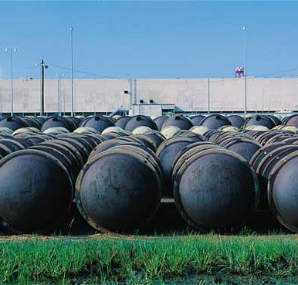Global Laser Enrichment has announced plans to slow down its commercialization activities, blaming market conditions, but also said it remained optimistic about the technology.

Global Laser Enrichment has announced plans to slow down its commercialization activities, blaming market conditions, but also said it remained optimistic about the technology.
GLE said most contractor work on the project would stop, and it would place the Oak Ridge, Tennessee site that is doing tk in safe storage. It said it would concentrate its development efforts at its Wilmington, North Carolina facility, where it successfully completed a test loop demonstration.
GLE is a joint venture of GE (51%), Hitachi (25%) and Cameco (24%). The GLE technology is licensed from Silex Systems Ltd of Australia, which stands to earn perpetual royalties of 7-12% of GLE revenues, depending on production costs.
Silex also said that GLE-funded activities at the laser development facillity at Lucas Heights, Sydney would also cease.
Silex said that the announcement came as a surprise. "Although Silex monitors the broader uranium market conditions, GLE’s announcement was unexpected. GLE has invested hundreds of millions of dollars to date, and subject to satisfactory economics, market conditions and regulatory requirements, continues to fund the program towards potential commercialisation."
Following adverse trends in the uranium and enrichment market, in June Silex announed that it is restructuring its operations for ‘financial and operational benefit’, in which it is divesting three subsidiary businesses, ChronoLogic, Translucent and Solar Systems.
Despite the problems in the market, GLE continues to discuss the possibility of building a laser enrichment facility at Paducah, Kentucky to enrich depleted tails with the US Department of Energy. GLE was chosen by DOE in November 2013 to manage Paducah and re-enrich tails. Negotiations include the sale of the uranium hexafluoride inventory stored there.
In an investor question and answer document, Silex said: "Silex has been informed that negotiations concerning the establishment of the Paducah Laser Enrichment Facility (PLEF) continue to proceed constructively, albeit slower than hoped. Whilst we await an outcome in these negotiations, it is important to understand that this proposal involves the potential disposition of hundreds of thousands of tons of depleted tails inventories owned by the DOE over a 40 year period. In this light, it is not entirely unexpected that the negotiations, which only began in earnest in the new year, have taken longer than originally indicated.
"Subject to prevailing market conditions and regulatory requirements being met, a positive outcome from these negotiations would potentially provide a clear path to market for our disruptive laser enrichment technology and set a strong commercial path for Silex. Shareholders should however also appreciate that the market for nuclear fuel will remain quite depressed in the short term at least, with both uranium and enrichment pricing at decade lows and unlikely to begin recovering until reactor restarts occur in Japan."
GLE’s laser enrichment process received approval by the USNRC in 2012.
GLE said that in the process uranium hexafluoride is vaporized into a gaseous form and exposed to a laser beam that preferentially excites the 235-UF6 isotope, which enables separation of natural uranium into enriched and depleted uranium. The operation, while technically complex, is potentially more efficient than existing second-generation centrifuge enrichment technology.
Picture: Drums of depleted uranium hexafluoride at Paducah, Kentucky, which might be GLE’s best prospects for commercialization
